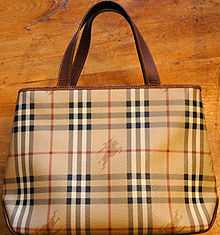Tote bag

A tote bag is a large and often unfastened bag, with parallel handles that emerge from the sides of its pouch.[1][2]
Description
The archetypal tote is made of sturdy cloth, perhaps with thick leather at handles or bottom; leather versions often have a pebbled surface. Common fabrics include heavy canvas, possibly dyed, or treated to resist moisture and mold. Jute is another traditional material, though less popular. In recent decades, heavy nylon and other easy-care synthetics have become common, although these may degrade with prolonged sun-exposure. Many of today's inexpensive or free totes are often made from recycled matter, from minimally-processed natural fibers, or from byproducts of processes that refine organic materials.
History
The term tote or tate, meaning "to carry", can be traced back to the 17th century but was not used to describe bags until 1900. However, the tote bag craze in the United States began in the 1940s with the release of L.L. Bean's Boat Bag in 1944.[3] Because they were easier than carrying luggage, most people opted for using tote bags. During the 1950s, tote bags began to enter into the main culture. Women primarily utilized them as practical handheld bags because they didn't require much care. It wasn't until the 1960s when the tote bag embraced personal style. Bonnie Cohen released her own line of tote bags called Cashin Carry Tote Bags which combined style and functionality. In the 1990s, Kate Spade ultimately transformed how American culture embraced tote bags when she began carrying them as fashion bags. Today, fashion lovers and consumers can find tote bags in a variety of decorations and themes.
References
- ↑ http://stylenews.peoplestylewatch.com/2013/03/25/joyus-exclusive-deal-joia-tote-bag/
- ↑ http://www.washingtonpost.com/local/police-release-video-of-man-robbing-bank-near-fbi-headquarters/2013/04/01/199e2c14-9b10-11e2-9bda-edd1a7fb557d_story.html
- ↑ http://www.fabric-and-handle.com/articles/history-of-tote-bags/
| ||||||||||||||||||||